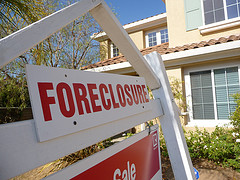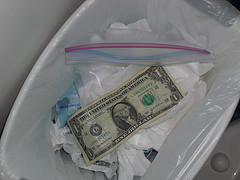 Fannie and Freddie were both conceived as Government Structured Enterprises – part private and part public. Without strict regulations against lobbing, such an arrangement assured that the private side would promote profits for the private side. One solution would be to replace Fannie and Freddie with a national mortgage bank.
Fannie and Freddie were both conceived as Government Structured Enterprises – part private and part public. Without strict regulations against lobbing, such an arrangement assured that the private side would promote profits for the private side. One solution would be to replace Fannie and Freddie with a national mortgage bank.
The goals of such a bank would be to ensure affordable housing, recognize the real value of property, promote communities, and provide a zero risk mortgage market for investors such as pension funds.
[social_buttons]
According to former Fed chief, Alan Greenspan on CNBC, “You cannot have a type of organization which is half public, half private. Essentially, the profit turns out to be for the private sector and the losses are socialized.” So what was Greenspan doing while at the Fed?
Fannie and Freddie have spent more than $200 million on campaign contributions and lobbying in the last decade. According to NPR they hold the record fine for illegal contributions – $3.8 million. The politicians continue to recite the “homeowners myth.” – that homeownership is a family value, it instill community roots, and helps families build a nest egg.
Politicians still talk about restoring the house market, yet it was the high price of houses that squeezed households dry and resulted in foreclosures. Some seem to believe that they can continue the real estate ponzi scheme indefinitely.
So much do they believe, or pretend to believe such propaganda that they are willing to tolerate monetary inflation and offer tax deductions to homeowner while passing the burden to renters. They rant against taxes claiming that they places a burden on homeowners, yet house prices and mortgage payments kept rising after tax cuts to claim any excess disposable income. Reducing tax revenues has resulted in states and cities cutting services and laying off workers.
The design of a national mortgage bank must work in concert with other government policies. Such policies are made clear by examining the most common foreclosure factors – reduced income from job lost, unexpected health problems, and death.
The effects of all these factors would be reduced by lower house prices. The Health problem factor would be reduced by a national healthcare plan. Paying realistic unemployment compensation and providing government work projects could reduce the job loss factor.
To understand how taxes can play a role in a national mortgage bank, we must consider new ideas regarding land ownership and taxes – actually, old ideas of Adam Smith, David Ricardo and Henry George.
Economics students are often startled to learn that the founders of capitalism rejected private ownership of land. Adam Smith observed that the low price of land in the British American Colonies enabled opportunity and created upward mobility. David Ricardo saw raw land as a natural resource. According to his Labor Theory of Value, the real value of land is the results of improvements made by labor. Thus the improvements belong to the occupant, but the raw land belonged to the state. Ricardo suggested that all land users pay a tax on the unimproved value of their land.
In the late nineteenth century, the American social reformer Henry George redesigned Ricardo’s land tax concepts, to encompass the industrial revolution. He proposed a “land-value-tax.” Such a tax would exempt any improvements placed on the land by the occupant, but would consider value added by infrastructure – schools, roads and other community services.
Since the late 1990s there’s been increasing interest in this tax as a way to solve the problems of “urban sprawl” – destruction of natural areas and parks, increase commuter traffic, air pollution, decrease in the tax base, vacant lots, abandoned buildings, and deterioration of a sense of community. The use of land value tax in Pittsburgh and Harrisburg, Pennsylvania has dramatically demonstrated that such a tax can revitalize communities.
While homeowners do not have immediate control over their tax structure, incentives for taxes structure that reduce foreclosure and contribute to the real value of the homeowners’ equity should be built into the new system.
The new system could have mortgage insurance similar to FDIC. This insurance could be part of the homeowners “monthly payments” – interest, equity, insurance and taxes.
A national mortgage bank can greatly reduce a homeowners’ monthly payment while increasing the real value of the homeowners’ property by making tax contribution to improve the homeowners’ community.
Also see:
How Alan Greenspan Tricked America
From Mortgage to Bailout: How Did The Problem Arise?
To Bailout or Not to Bailout: Is Free Market Economics Sustainale?
Photo Credit: respres via Flickr’s Media Commons








Very good and concise piece. A national version of the Pennsylvania land value tax experience (not to mention the much more widespread application in New Zealand and Australia) makes all the more sense when we realize that the real estate bubble is actually a land bubble, and those bubbles and “pops” thereof are the precursors of each boom and bust.
The money went somewhere, and we’ll never get it back, this time. Private pocketing of public economic land rent is a huge swindle, but economic rent is easily detected and found. We need the political will to give back to the community that which the community creates.
Thank you again.
Very good and concise piece. A national version of the Pennsylvania land value tax experience (not to mention the much more widespread application in New Zealand and Australia) makes all the more sense when we realize that the real estate bubble is actually a land bubble, and those bubbles and “pops” thereof are the precursors of each boom and bust.
The money went somewhere, and we’ll never get it back, this time. Private pocketing of public economic land rent is a huge swindle, but economic rent is easily detected and found. We need the political will to give back to the community that which the community creates.
Thank you again.
The almost unreported factor in the Mortgage Mess is the land value factor. Historically, land value was 10% to 20% of the price of a house. In 2006 land value was bid up to 60% -70% of the house price. The regulator of Fannie and Freddie had this information available and ignorred it (land value is recorded in every standard real estate appraisal). Widely reported is the statement that house prices never declined before. This is false! Aggregate figures for nationwide measures of house values never declined,but individual prices and regional prices have declined to zero. Collateral is individual properties wirh individual market values. Land values collapse on avergage every 18 years. Lending policy must consider this fact. Equity should finance land sales.
The almost unreported factor in the Mortgage Mess is the land value factor. Historically, land value was 10% to 20% of the price of a house. In 2006 land value was bid up to 60% -70% of the house price. The regulator of Fannie and Freddie had this information available and ignorred it (land value is recorded in every standard real estate appraisal). Widely reported is the statement that house prices never declined before. This is false! Aggregate figures for nationwide measures of house values never declined,but individual prices and regional prices have declined to zero. Collateral is individual properties wirh individual market values. Land values collapse on avergage every 18 years. Lending policy must consider this fact. Equity should finance land sales.